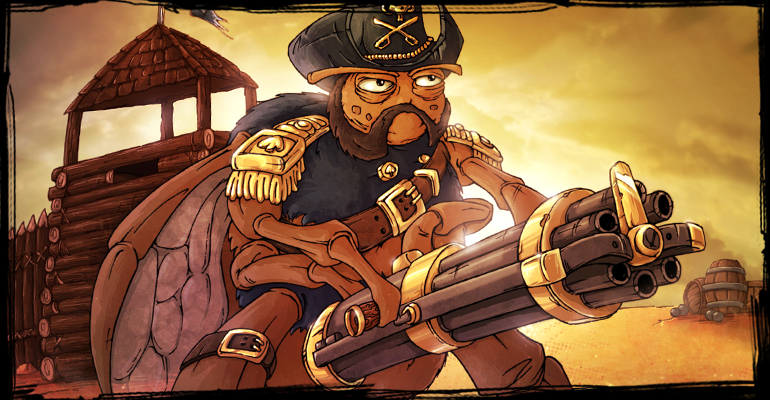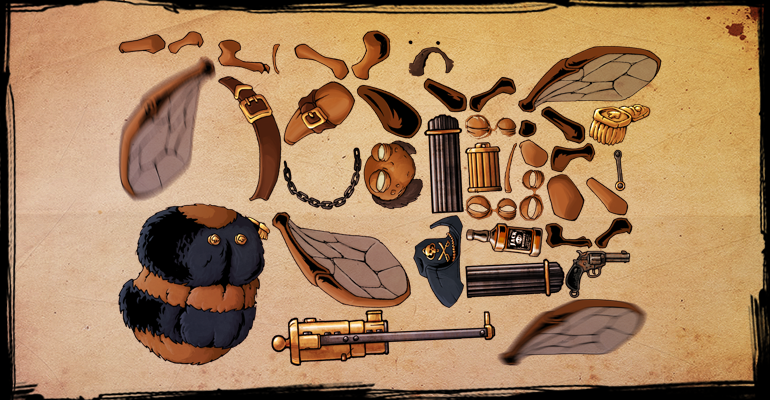Every time I have the opportunity, I say (as a sort of apology) that I am a self-taught 2D animator with very little experience. There are a lot of firsts for me, working on Blood will be Spilled and trying out 2D rigging of characters was one of them. During the last two years I have done quite a few animations for the game and then redone them again and again until I finally found a process and a personal set of rules that seems to work for me. I would like to tell you about them using one of our characters as an example.
The Character
When doing a character animation we always start out (well, obviously) with designing the character. Every character serves some purpose in the game, whether it’s an enemy, a major NPC or some insignificant character in the background. So during the design process, we ask ourselves questions like: ‘Will this character stand on two or four legs? Are we planning on changing his clothes and accessories in the future? Do we need him to walk, run, fly or fight?’ etc. Then, my brother does some sketches and then move on to drawing up the final design. For more important characters we usually have some ‘mood’ pictures as well, that tells us more about the character (and they also serve us as marketing materials).
The Rules
I’ll admit that this sounds a lot more sophisticated than it actually is. What I mean by “rules” are some personal principles I try to follow every time I do an animation:
- First of all, I always try to follow 12 principles of animation as closely as possible, except the “squash & stretch” which I use only very occasionally.
- Second rule is that even though Blood will be Spilled isn’t necessarily a funny game, since we have insect cowboys with guns as our characters, there simply has to be something humorous about them. So, I always try to make them look slightly funny if possible – whether it’s for example the way they walk, or their sloppy gun-handling skills.
- Third and final rule is that everything needs to have a secondary motion, which shouldn’t be overdone, but still should be noticeable. All of our characters are usually done in a way that allows for secondary animation of some accessories or hats while they do their primary motion.
The Process
Cutting the character model in pieces
First thing I do with a character model is cutting it into pieces. With insects, this is a little easier to do than it would be with human characters (because who would want to cut humans into pieces? What are we, mafia?) as their bodies are naturally divided into parts (Insects, from Latin insectum -“cut into sections”). Then I put the character back together and export all the parts as individual images.
Importing into Spine & creating a skeleton
For 2D animation I use Spine by Esoteric Software. It is a 2D rigging software in which each image is applied to an appropriate bone of a skeleton. This is the first step on the journey of breathing life into our characters.
Adding inverse kinematics
After putting the skeleton together I add inverse kinematics (IK) to certain bones, such as feet and arms. IK, as the name suggests is the opposite of forward kinematics (FK). In forward kinematics, each bone follows the properties of the parent bone. In inverse kinematics you move for example the ankle and the knee bends accordingly. I use this to make sure that character feet always stay on the ground.
Animation
Once everything has been set up I start animating. With characters like Ace, for example, I always have a checklist of sorts of all the animation we need him to have. Usually this includes idle (calm), idle (aggressive), walk, run, shoot, crouch/cover and sometimes flying.
Secondary motion
As i mentioned before, I always like for my animations to have some secondary motion (which is one of the 12 principles I mentioned before). While an animation without it pretty much serves it’s purpose well enough, animations with secondary motion looks more juicy and alive. In my opinion, this is an important part of creating a pleasant game feel in 2D games.
Special animations
Some of our characters also have some funny idle animations which adds a bit more flavor to the character. Usually, if I wasn’t able to put some humor into other animations, I try to supplement it in these special ones. For example, in the animation below, our character Ace (inspired by heavy metal icon Lemmy) takes a sip from his bottle of bourbon.
And that’s it for today. If you like our animations, our work or just want to follow our progress, be sure to follow our progress on facebook, twitter, or instagram. Take care cowboys!










